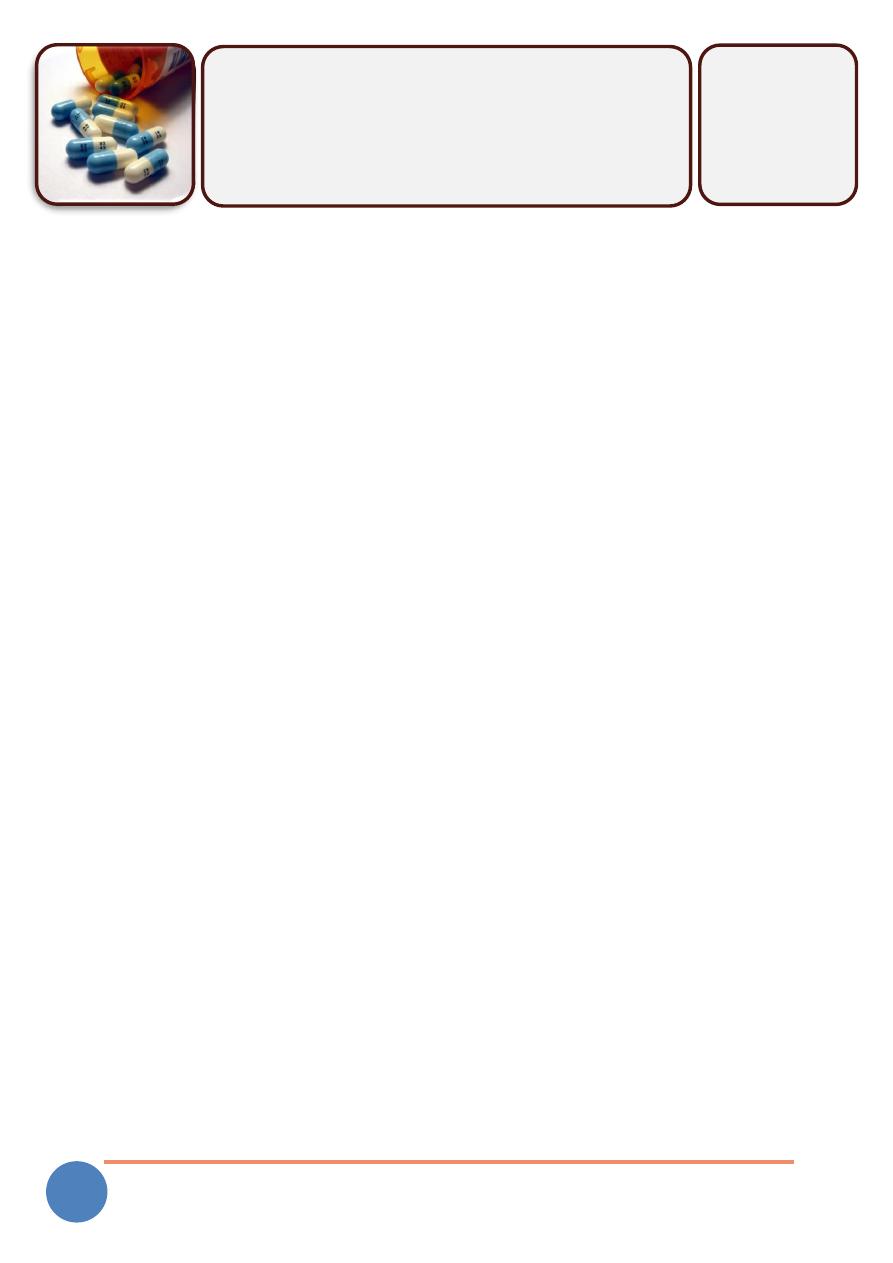
1
B
y:
M
oh
am
m
ed
S
al
im
Pharmacology
3
rd
Stage
Dr. Nabeel
Mechanism of Drug Action
Pharmacodynamics
Mechanisms of drug action:
1. Receptor occupation as cholinergic, adrenergic and histamine receptors,
occupied by acetylcholine, adrenaline and histamine respectively
2. Interference with ion channels, some drugs acts directly on ion channels and
alters their function as local anaesthetics act by blocking Na+-channels
3. Inhibition of membrane bound enzymes as Na+/K+ ATP-ase inhibition by
digoxin
4. Through physicochemical properties; like osmotic effect as magnesium
sulphate, a laxatives acts by increasing water in the faecal material and
facilitate their passage through the colon, manitol acts as osmotic diuretic
5. Direct chemical reaction as the use of alklines to neutralize gastric acid in
the stomach and Chelating agents as penicillamine in heavy metals
poisoning
6. Enzyme inhibition as cholinesterase inhibition by nesostigmine and
angiotension converting enzyme inhibition by captopril
7. Antimicrobial cause inhibition of bacterial metabolic processes as
sulphonamide inhibit bacterial dihydrofolate reductase enzyme, this lead to
inhibition of folic acid synthesis by the bacteria, but not affect the human
which does not synthesis folic acid
8. Carrier mechanism: some drugs act by interfering with passage of olecules
across the cell membrane such as the inhibition of neradrenaline uptake by
tircyclic antidepressants, carrier mechanism is important for the transport
of moplecules as glucose, amino acids and organic molecules.

2
Receptors
are protein macromolecules situated usually but not always situated on the cell
membrane and has the ability to combine with the drug molecule, and transmit
the drug effect to the inside of the cell. The drug molecule has to be similar in size,
shape, chemical structure in order to combine to its specific receptor. So the
receptors are important for the specific and selective action of the drug.
Usually the presence of receptors indicate that there are endogenous substances
of similar shape that can combine to these receptors such as endogenous opiates
that bind to opiates receptors, adrenaline and noradrenaline that combines to
adrenoceptros
Mechanisms of drug binding to receptors:
1. Covalent binding: are strong and usually irreversible bonds and rarely
mediate drug effect as cytotoxic drugs
2. Electrostatic bonds: are more common than covalent binding
3. Hydrophobic bonds: are usually are weak bonds and are important in highly
lipid soluble drugs binding with the lipids cell membranes
Receptors can be divided into three different types:
1. Receptors linked to ion channels: these receptors regulate the flow of ions
across their channels in the cell membrane example; nicotinic cholinergic
receptors and Na+ ion channels, GABA receptors and Cl- ion channels, they
are activated in milliseconds
2. G-protein coupled receptors: these receptors are linked to G protein which
mediate the intracellular action by binding to guanosine triphosphate. This
will lead to the activation of a second messenger mechanism called
adenylcyclase which result in the production of cyclic-adenosine
monophosphate(cAMP), and this regulate protein phosphorylation, they
acts in seconds to minutes, as the beta-adrenoceptors
3. Intracellular receptors; these receptors are located inside the cell ad
therefore the drug molecule must diffuse to the inside of the cell to interact
with these receptor as in estrogen receptors which are located in the
nucleus of the cell and they stimulates DNA and proteins synthesis and
usually take hours to act, also corticosteroids has similar receptors

3
Second messenger:
The second messenger is an intracellur component that can transmit the effect of
the drug to the inside of the cell following receptor stimulation, such as cyclic
adenosine monophosphate (c-AMP) and calcium ions, changes in these second
messenger will produce the drug effects as muscle contraction or relaxation or
gland secretion.
Receptors regulations:
The response to drug depends on the number of receptors occupied.
The number of receptors may be affected by the continued presence of the
drug.
In general the number of receptors tend to decrease with continuous agonist
drug administration and this will lead to decrease in drug response
(receptors down-regulation) This is in order to protect the cell from excessive
stimulation.
The reduction in receptors occur by the process of endocytosis, which means
that the cell engulf the receptors and degrade it
Tachyphylaxis
rapid reduction in the response to the drug following repeated administration (this
is due to receptors down-regulation)
The continuous administration of the antagonist will increase the number of
receptors (receptors up-regulation), which makes sudden withdrawal of the
antagonist dangerous after prolonged use as beta-blockers
Dose response relation
The effect produce by a drug is generally a function of the amount of the drug
administered "dose-Response Curve". The magnitude of the drug effect depend on
its concentration at the receptor site, which is in term determined by the dose of
the drug administered and affected by factors related to the drug characteristics
and the pharmacokinetics parameters.

4
Dose-Response Curve:
As the concentration of the drug increase, the magnitude of its pharmacological
effect will also increase( i.e. increasing the drug amount will increase the
response). The curve has S shape with a linear part in the middle.
Quantal-dose response (dose percent effect)
for determination of drug response in the population, it is used for all or none
effect as prevention of convulsion, cardiac arrhythmias and in acute toxicity
studies.
Therapeutic index
is the ratio of toxic dose to the effective dose
Therapeutic index = toxic dose/effective dose
Therapeutic index is a measure of the drug safety, the larger the index, the
safer is the drug .
Lethal dose (LD50)
it is the dose that kills 50% of the experimental animals, it is also useful in finding
the therapeutic dose in the early experimental studies of drug discovery. It can
also be used to measure the therapeutic index a follow:
Therapeutic index = LD50/ ED50
LD 50 is the lethal dose in 50% of animals
ED50 is the effective dose in 50% of the animals
Agonist
any substance which has the affinity to combine with the receptors and causes
receptors stimulation and pharmacological action. Example is acetylcholine which
combine to muscarinic receptors and adrenaline which combine to the adrenergic
receptors.

5
Partial agonist
is a drug which has affinity and some efficacy to the receptors and it does not
produce maximum effect even when all the receptors are occupied and it may
antagonize the action of other agonist that have a greater efficacy
Antagonists
is the substance which has the affinity for the receptors but when combine with
the receptors does not cause stimulation. The antagonist usually block or
antagonize the effect of the agonist. Example atropine which can combine with
muscarinic receptors and antagonize the effects of acetylcholine, also propranolol
can combine with adrenergic receptors and antagonized the effects of adrenaline
Sensitivity
is the ability of a given dose of a drug to act on one system rather than the other
Affinity
is the ability to combine with receptors , drugs has high affinity will displace
drugs with low affinity from receptors binding
Potency
is a given response for certain receptor occupation, the more potent drug will give
similar response at lower doses than the less potent drug, this usually determine
the dose of the drug
Efficacy
is the maximum response to drug, that is no further increase in response occur
when we increase the dose. Drugs can have high efficacy as frusemide or low
efficacy as spironolactone

6
Competitive antagonism
when two drugs compete on the same receptor site, it occur between two drugs of
similar chemical structure and usually occur between the agonist and its
antagonist on the same receptor site, example atropine can compete with
acetylcholine on the muscarinic receptors. The antagonist cause parallel shift to
the right of the dose response curve (i.e. you need higher dose to produce the same
effect)
Physiological antagonism
Occur when two drugs antagonize the effect of each other, but they act on two
different receptors ( the drugs have opposing pharmcological actions). Example is
histamine which act on histaminic receptors and cause vasodilatation, while
adrenaline acts on adrenergic receptors and cause vasoconstriction , so adrenaline
is a physiological antagonist to histamine and it is useful in anaphylactic reactions
Factors modifying drug response:
1. Age: various physiological changes with age that might affect the
pharmacokinetics or pharmacodynamics of drugs include body fat contents,
volume of distribution, hepatic blood flow, glomerular filtration rate and
changes in homeostatic mechanisms
2. Body weight: as this affect the body fluids and fat, which may change the
drug concentration in the body
3. Gender : generally lower doses for females also note hormonal, changes,
menstruation, pregnancy and lactation. This can also modify the adverse
effects of the drugs ِ
4. Racial factors Negros, Asians and Caucasians, may show different response
to the same drug
5. Genetic factors: as variation in cytohcrome P450 enzymes will alter the rate
of drug metabolism, also genetic deficiency of G6PD enzyme will lead to
hemolysis of the red blood cell by some drugs as primaquine
6. Disease states: include hepatic and renal diseases. These can change drug
metabolism rate, drug clearance from the body and the body response to
drugs
7. Drug: dose, route of administration, frequency of administration, drug
interactions, tolerance and tachyphylaxis

7
No drug produce only a single specific effect
Drug may act on the same receptors at different cells or it may act on different
receptors at the same time
Drug effects can be divided into toxic (adverse or unwanted) and (therapeutic
or useful)
